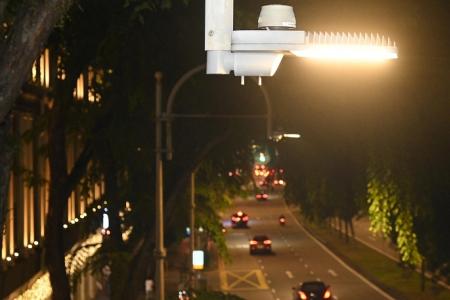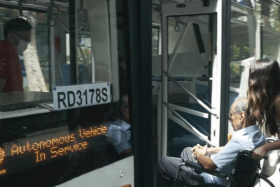Smart light system to be installed by mid-2025
The smart light system used in street lamps across Singapore will be installed along walkways, cycling paths and overhead bridges, and at bus stops and taxi stands by mid-2025.
For the past year, all street lamps in Singapore – more than 110,000 of them – have been remotely turned off and on in response to weather conditions and changing street-lighting needs throughout the day.
In September 2023, Singapore became the first country in the world to convert all its street lamps into smart ones under a remote control and monitoring system (RCMS).
The system has resulted in savings on energy use and labour to monitor faults and manually turn lights on and off. It has also enabled a more efficient and responsive maintenance regime, the Land Transport Authority (LTA) said.
RCMS will be expanded to cover 350km of covered walkways and 525km of cycling paths, as well as 560 pedestrian overhead bridges and 4,400 bus stops and taxi stands, LTA announced on Oct 2. The agency manages these public facilities.
At present, around 30 per cent of lights at such commuter facilities are equipped with RCMS technology. They were installed between March and August.
When RCMS is rolled out fully to commuter facilities by mid-2025, it is expected to result in energy savings of about 0.124 million kWh yearly.
With RCMS, street lamps are using 8.75 million kWh less energy in a year than before, LTA said. This is equivalent to the energy needed to power roughly 2,000 four-room flats in a year.
On the maintenance and management of street lamps, the system is able to detect faults and alert maintenance staff, who are typically deployed for repairs on the same day.
This has resulted in an 80 per cent drop in public feedback on maintenance issues. Before RCMS was implemented, LTA used to receive about 800 pieces of feedback every month.
The system has also eliminated the need for nightly patrols to identify faulty lamps, a labour-intensive task that saves LTA about 4,200 man hours every year.
Before RCMS was installed, street lamps had to be manually turned on in periods of low visibility, such as during heavy rain and haze. This was labour-intensive and took hours, as staff had to travel to about 5,700 control boxes all over Singapore to turn the lights on. Each control box controlled a group of street lamps.
The opportunity for LTA to explore using a smart street-lighting control system came in the 2010s. That was when the older high-pressure sodium vapour street lamps were gradually replaced with light-emitting diodes (LEDs), which are brighter, and offer better visibility for motorists and pedestrians.
As LTA replaced every street light with an LED lamp, it also installed RCMS and its control nodes on each lamp.
The control nodes are described by LTA’s engineers as the “brains” of the RCMS.
Each control node is programmed with its own calendar, so it knows precisely what time to turn off and on each day, depending on sunrise and sunset times that change throughout the year, based on meteorological data.
Nodes also collect information such as the temperature of the lamp and other data points to ensure the lamp is working well.
A light sensor in each node collects data about its surroundings to determine how bright it is.
All the data from the nodes are transmitted to LTA via a 4G network for analysis and, taken together, can determine whether a light or visibility threshold has been crossed. If so, LTA can remotely turn on the street lamps in a certain area.
The installation of RCMS for street lamps began in 2018 and was supposed to be completed by 2022. But supply chain challenges during the Covid-19 pandemic pushed the completion to September 2023.
It cost the authority $76.3 million to install the RCMS and convert 25,000 street lamps in central Singapore to LED.
Get The New Paper on your phone with the free TNP app. Download from the Apple App Store or Google Play Store now


